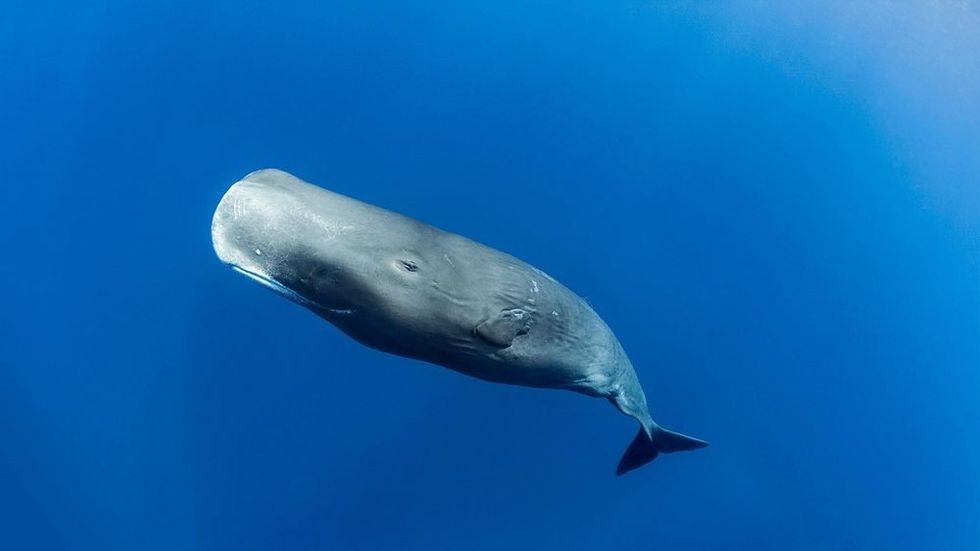What are the different sizes of whales?
Whales have reserved their spots as the largest marine animal in the animal kingdom. Whales vary in size and body length based on the species they belong to and which part of the ocean they swim in.
Minke Whale - The minke whale is considered to be the second smallest species of baleen whales, right after the pygmy right whale species.
The minke whale species is black, purple, or dark gray in color, and because it is a baleen whale species, this creature is carnivorous in nature. The minke whale is divided into two further groups, and depending on its natural habitat, it is distinguished by the names northern minke whale and Antarctic minke whale.
This marine creature has a lifespan that ranges between 40-50 years.
On average, the females have a body length of 26 ft (7.9 m), compared to the males' body length of 23 ft (7 m). Both males and females have an average weight of 10 tons.
However, the minke whale size at its largest is estimated to be around 35 ft (10.6 m) for females and 32 ft (9.7 m) for males, with both weighing around 6.1 U.S. tons (5,600 kg).
Bryde's Whale - Named after John Bryde, the Bryde's whale, is another huge whale species that is found in the coastal waters of Southern Africa, however, this range is not limited as the Bryde's whale can also be found in Mexican, Californian, Caribbean and Hawaiian waters.
The Bryde's whale resides in subtropical and tropical waters and is gray-colored.
The average adult size of Bryde's whale is estimated to range between 42.6-49.2 ft (13-15 m) in body length, and their weight is recognized to be up to 45 U.S. tons (40,823.3 kg).
These whales are a social species and prefer to stay in pairs but can be seen in large groups when they approach the surface to breathe or during feeding time.
Gray Whale - The gray whale, also known as the California gray whale or the Pacific gray whale, is a species of whale that is found in the coastal waters of California.
During the 18th century, the gray whale made the North Atlantic its home before being practically wiped from the world due to whaling.
On average, the gray whale has a body length of 49 ft (14.9 m), and an adult can grow up to have a body mass of at least 38 U.S. tons (35,000 kg). As is common with most whale species, the females are larger than the males.
The lifespan of the gray whale is still unknown, however, there are reports that one female reaches the age of 75-80 years.
Sei Whale - The sei whale is another member of the baleen whale group. The sei whale is found in subtropical, subpolar, and temperate waters all around the world.
The Sei whale species is distinguished from other whales by its dark gray coloration and marking on the exterior of the body that is white color.
The sei whale has an estimated lifespan that ranges between 50-70 years, and it can grow between 40-65 ft (12.1-19.8 m) in length. The sei whale weight is estimated to weigh around 31 U.S. tons (28,122.7 kg).
Humpback Whale - It is one of the most well-known whale species because it is often spotted by humans when they come to the surface to breathe air or breach. The name humpback comes from the hump that is present in front of their tiny dorsal fin.
The humpback whale spends a large chunk of its time at the water surface, which makes photographing them easier.
Humpback whales are migratory in nature, and females give birth to calves in the winter. Humpback whales have a lifespan between 80-90 years and achieve a maximum length of 52 ft (15.8 m), and the weight of this whale ranges between 33-39.6 U.S. tons (29,937.1-35,924.5 kg).
Bowhead Whale - The bowhead whale is considered to have the largest mouth of all whale species, and it also lacks the dorsal fin that is common in whales.
The Bowhead whale can be found in the Arctic and Subarctic regions, where they traverse through the cold Arctic waters. The bowhead whale has an estimated lifespan that is 100 years and over and reaches an average body length of 59 ft (17.9 m).
The weight of the bowhead whale is considered massive as this whale weighs well over 110 U.S. tons (99,790.3 kg).
The Right Whale - The right whale species is made up of three comparable species of whales that include the North Pacific right whale, the Southern right whale, and the North Atlantic right whale.
The right whale species is distinguished from other whales by their dark skin and V-shaped blowhole. The female right whale is comparatively larger than the males as they reach a body length of 60 ft (18.2 m) compared to the males' 56 ft (17 m) body.
The North Atlantic right whale weighs around 70 U.S. tons (63,502.9 kg) as a full-grown adult.
Sperm Whale - The sperm whale is considered to be the biggest of all toothed whales and is among the few whale species that can live in various marine ecosystems, because of which they travel oceans all around the world.
The female Sperm whale lives a social life, whereas the males live a solitary life, except during the mating season. The average life expectancy of the Sperm whale is estimated at around 60 years, and these whales grow an average length between 40-52 ft (12.1-15.8 m) depending on the sex, as females are smaller than males.
The overall weight of this whale is between 25-56 U.S. tons (22,679.6-50,802.3 kg).
Fin Whale - The Fin whale, also known as the Razorback whale, holds the record for being the second-largest whale species in the world. The Fin whale body is long and thin, and it has a dark brown body that is complemented with an underside that is white.
The Fin whale is found in waters ranging from the Arctic Ocean to the Pacific Ocean. This huge whale species grows between 75-85 ft (22.8-25.9 m) and will weigh around 80 U.S. tons (72,574.8 kg).
Blue Whale - The Blue whale is the largest mammal and the biggest whale to ever exist on the planet, and it is the largest whale species in existence. Blue whales are known to have an average length of 70-80 ft (21.3-24.3 m), but the largest and lengthiest are estimated to be over 110 ft (33.5 m) in length!
These massive creatures weigh between 143-165 U.S tons (1,29,727-1,49,685 kg).
Blue whales are one of the many marine animals that have faced massive population decline. Today, blue whales are found in the North Pacific, Southern Hemisphere, and the North Atlantic.
Despite being the largest whale species in the world, blue whales are not exempt from predators in the form of the killer whale or orca (Orcinus orca).










